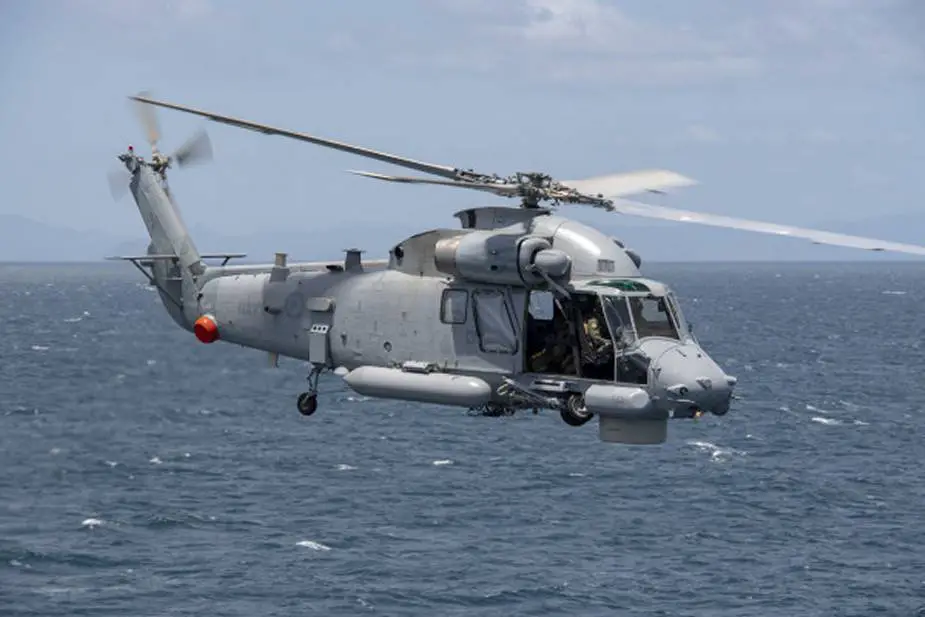Breaking news
New Zealand Ministry of Defence looking for new naval helicopters.
According to Phil Pennington on Radio New Zealand (RNZ) on April 24, the Ministry of Defence is looking for proposals on buying about $1 billion worth of naval helicopters, and drones. A tender for proposals for replacing RNZN’s Kaman SH-2G(NZ) Seasprite helicopters will go out shortly, deputy secretary of Defence Policy and Planning Richard Schmidt told RNZ: "The request for information will be seeking proposals for both naval helicopters and uncrewed aerial vehicles. "It is a market research tool to support the next steps and provides an opportunity for the industry to provide information on options. No decisions have been made.".
Follow Air Recognition on Google News at this link
 The Kaman SH-2G Seasprite's primary missions include anti-submarine and anti-surface warfare, anti-ship missile defense, and anti-ship surveillance and targeting (Picture source: RNZN)
The Kaman SH-2G Seasprite's primary missions include anti-submarine and anti-surface warfare, anti-ship missile defense, and anti-ship surveillance and targeting (Picture source: RNZN)
The Kaman SH-2G Super Seasprite is a ship-based helicopter with anti-submarine, anti-surface threat capability, including over-the-horizon targeting. This aircraft extends and increases shipboard sensor and weapon capabilities against several types of enemy threats, including submarines of all types, surface ships, and patrol craft that may be armed with anti-ship missiles. It was originally developed for the U.S. Navy in the 1980s as a re-engined version of the older Kaman SH-2 Seasprite.
The SH-2G's primary missions include anti-submarine and anti-surface warfare, anti-ship missile defense, and anti-ship surveillance and targeting. Secondary missions may include medical evacuation, search and rescue, personnel and cargo transfer, as well as small boat interdiction, amphibious assault air support, gunfire spotting, mine detection and battle damage assessment.
The Kaman SH-2G Seasprite in New Zealand service
The Royal New Zealand Navy (RNZN) replaced its Westland Wasps with four interim SH-2F Seasprites (ex-US Navy), to operate with Anzac-class frigates until the fleet of five new SH-2G Super Seasprites was delivered. The Navy air element was transferred to No. 6 Squadron RNZAF at RNZAF Base Auckland in Whenuapai in October 2005. RNZN Seasprites have seen service in East Timor.
New Zealand purchased five SH-2Gs at the same time as Australia. However, New Zealand opted for new-built airframes that were outfitted with different avionics. The SH-2G purchase was completed at NZ$12 million under the $338 million budgeted (excluding GST). The first RNZN SH-2G(NZ) was delivered in mid-2001, and the last was delivered in February 2003. The Royal New Zealand Navy (RNZN) operates the type from its two Anzac-class frigates, two Protector-class offshore patrol vessels, and the multi-role vessel HMNZS Canterbury. They were initially operated by the Naval Support Flight of No. 3 Squadron RNZAF, but now by No. 6 Squadron RNZAF.
In May 2012, Defence Minister Jonathan Coleman announced that Cabinet had given Defence officials approval to negotiate with Kaman Corporation for the 11 helicopters and flight simulator from the canceled Australian SH-2G(A) Super Seasprite project. It is thought the 11 helicopters, worth NZ$1.4 billion in 2008, would cost New Zealand between NZ$130 million to NZ$230 million. A decision to purchase ten of the helicopters for $NZ242 million was announced on 19 April 2013. Eight of the aircraft would enter service with the RNZAF to replace the existing five Seasprites, and the remaining two would be used as a source of spare parts.
The New Zealand Ministry of Defence accepted the first of the helicopters in the United States on 1 December 2014, and two more were delivered to Auckland in early 2015. Deliveries were completed by the end of 2015. All the aircraft were in service by 2016. The NZDF's five SH-2G(NZ) Seasprites were officially retired on 14 April 2016, and conducted their last flight on 21 April after serving since August 2001. They were replaced with eight re-manufactured SH-2G(I) models, allowing the Navy to embark up to three helicopters from ships at once instead of two. The "I" model also replaces the AGM-65 Maverick with the AGM-119 Penguin anti-ship missile. New Zealand's five SH-2G(NZ) models were sold to the Peruvian Navy in October 2014 and replaced by the eight SH-2G(I) models
The New-Zealander Kaman SH-2G(NZ) Seasprites are due to be replaced around 2028. In March 2015, the arrival of the first of 10 naval helicopters was the culmination of a long process to upgrade the helicopter fleet. The process began in the late 1990s and has cost over $1 billion. The naval Seasprites cap off a shopping list of helicopters that included the medium utility NH90. The SH-2G(I) can be equipped with Penguin anti-ship missiles, Mk.46 torpedoes and the FN MAG 58 General Purpose Machine Gun designed by Belgian firm FN Hertal.
The existing Seasprite fleet for the frigates costs only a quarter of the new proposal. The Defence plan in 2019 put the indicative cost of replacement at more than $1 billion: "Initial thinking on the replacement helicopters will need to determine the primary role of the aircraft."
 Secondary missions of the SH-2G Seasprites may include medical evacuation, search and rescue, personnel and cargo transfer, as well as small boat interdiction, amphibious assault air support, gunfire spotting, mine detection and battle damage assessment (Picture source: RNZN)
Secondary missions of the SH-2G Seasprites may include medical evacuation, search and rescue, personnel and cargo transfer, as well as small boat interdiction, amphibious assault air support, gunfire spotting, mine detection and battle damage assessment (Picture source: RNZN)


























